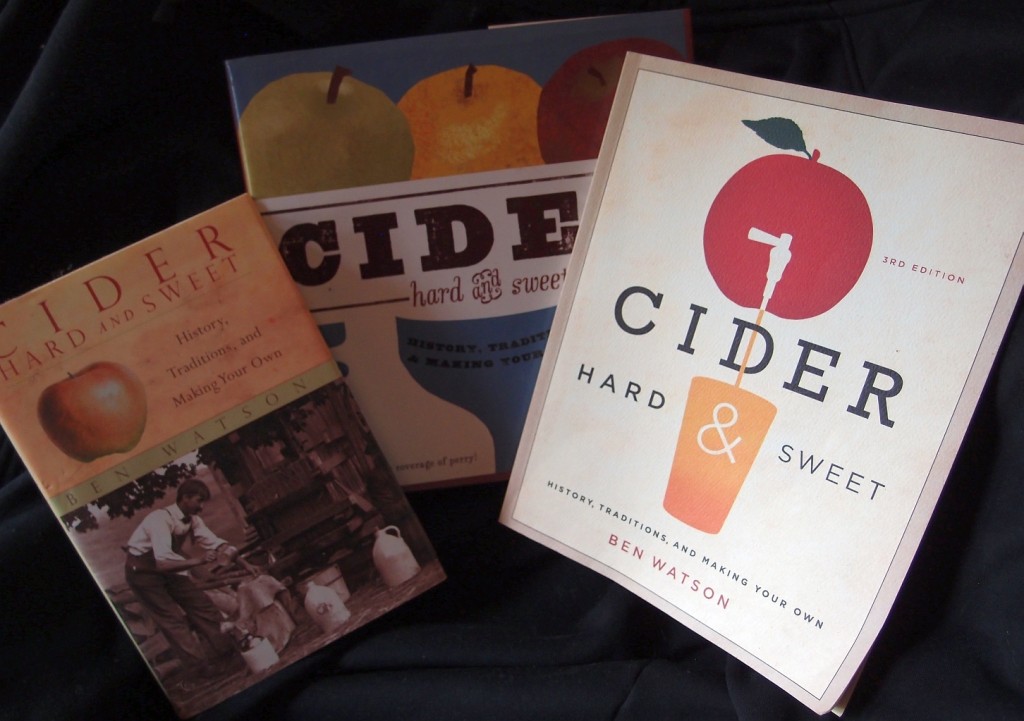Cider, Hard & Sweet, by Ben Watson, is now in its 3rd edition, and for good reason. This quintessential book on cider informs the reader in a clear and lively way. Reading it from cover to cover is enjoyable; opening it at random for a casual peruse will quickly get you sucked in. You’ve been warned—set the timer on the oven or dinner will be burned.
Watson sets out 10 clearly organized chapters, which cover: the history of cider, apple varieties for cider, sweet cider, hard cider, cider styles and traditions, tasting and evaluating cider, perry, cider vinegar and spirits, cooking with cider, and cidermaking: beyond the basics. Being my husband’s wife, I have often heard these topics casually discussed, but reading Watson’s book helped me put the information together in a cohesive way.
One of my favorite chapters was that on apple varieties for cider. Ben Watson begins by explaining why apple trees are often grafted—apples rarely reproduce “true to type” from seed, which greatly affects how new varieties are formed. Like me, you’ll surely learn something in the details he shares. However, most of this chapter is spent in more immediate concerns—the flavor profiles of different categories of apples, and how they can contribute to a well-rounded cider, which includes sweetness, acidity, bitterness, and aroma. Previously, I had been mystified by cider makers that blended apples in their chosen proportions before pressing—how did they know what they would end up with? Watson reveals that it’s less a matter of magic and more a matter of knowing your apple categories. Cider producers will enjoy using this chapter as a jumping-off point when considering adding different varieties to their orchards or cider blends.
Another interesting chapter is Stronger Waters: Cider Vinegar and Spirits. As a teacher, I know that learning in context is much more effective than learning in isolation; even if your main focus is cider, learning about other apple-based drinks will extend your knowledge and give you a rounder picture. The “stronger waters” covered in this chapter are: apple brandy, pommeau, apple jack, ice cider, and cider vinegar. You may have never heard of some of these beverages before, though a description of ice cider (made from “freezing fresh cider pressed from apples in the dead of winter”) will surely intrigue you. I can attest to its deliciousness, which I can only describe as something akin to maple syrup, but alcoholic and made with apples—anyway, it’s worth a try. Conversely, anecdotes of “apple palsy” might put you off applejack, but nevertheless, the section will entertain you.
There’s a chapter suited for every reader, and each is skillfully done. I’m interested, however, in seeing how the chapter “Cider Styles and Traditions” will change in future editions, as cider itself blossoms and changes in the United States. What new styles will be invented or reinvented? Which categories will expand?
This book is not a read-once-and-put-on-the-shelf affair. Our copy is smudged and dog-eared. Part of the reason for this is the way in which the content is displayed. Helpful sub-headings divvy up each chapter while relevant photographs, diagrams, and easy-to-read charts are peppered throughout. Readers are prompted to smile at the start of each chapter, which begins in a prescient quote or verse.
The strength of this book rests on Ben Watson’s talent for finding a balance between breadth and depth, covering ground in a way that piques the interest of the cider drinker and the cider maker alike. Reading this book is probably the quickest and most accurate way for your average imbibing layman to reach the ranks of cider connoisseur. What’s more, it’s painless—nay, it’s downright enjoyable.
Order Online: Amazon.com, Powells.com, Amazon.co.uk

